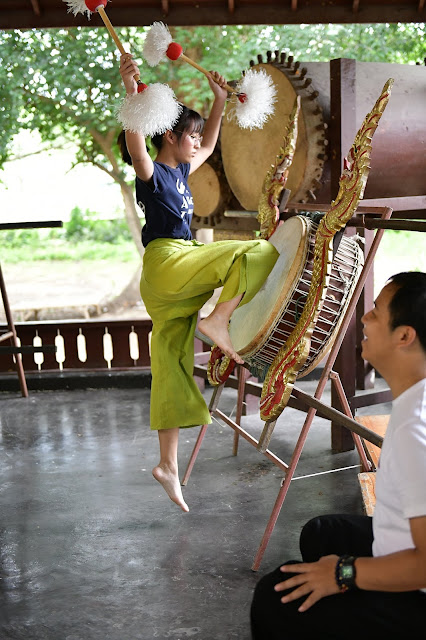Klong Sabud Chai
ประวัติความเป็นมาของกลองสะบัดชัยมีการใช้กลองสะบัดชัยมาตั้งแต่สมัยอดีต ไม่มี หลักฐานแน่ชัดว่ามาจากที่ใด แต่พบในบันทึกตั้งแต่สมัยพระยามังราย ประมาณ พ.ศ. 1800 และมีการสืบทอดต่อกันมาจนถึงปัจจุบัน ชื่อของกลองเรียกแตกต่างตามการเปลี่ยนแปลงของ สังคมและวัฒนธรรมคือ กลองจัย กลองปู่จา กลองสะบัดชัยโบราณ และกลองสะบัดชัยประยุกต์ ลักษณะทางกายภาพเป็นกลองขึงหนังสองหน้าขนาดใหญ่ มีกลองขนาดเล็ก 2-3 ลูกอยู่ด้านข้าง ความเชื่อในกลองสะบัดชัยแบ่งเป็นความเชื่อทางศาสนาเพื่อใช้กลองสะบัดชัยสำหรับ การบูชาศาสนา ความเชื่อด้านความศักดิ์สิทธิ์ของกลอง เชื่อว่ากลองสะบัดชัยมีความ ศักดิ์สิทธิ์และเป็นของสูง สามารถบันดาลให้เกิดสิ่งมงคลต่าง ๆ บทบาทของกลองสะบัดชัย ในอดีตใช้ตีเพื่อให้เกิดความเป็นสิริมงคลแก่นักรบยามทำศึกสงคราม เป็นอาณัติสัญญาณในการ ทำยุทธวิธีการรบ เป็นเครื่องประโคมฉลองชัยเมื่อเสร็จจากการรบ ต่อมาบ้านเมืองไร้ศึก สงครามกลองสะบัดชัยได้ใช้ตีเป็นพุทธบูชา เป็นเครื่องส่งสัญญาณต่าง ๆ ในชุมชน
ปัจจุบัน นิยมใช้ในการบันเทิงตามงานบุญงานวัด จนกลายเป็นการแสดงทางศิลปวัฒนธรรมที่แพร่หลายใน ปัจจุบัน การวิเคราะห์ลักษณะทางดนตรีด้านจังหวะ พบว่า 1. โครงสร้างจังหวะ แบ่งเป็นลักษณะสองท่อนและลักษณะหลายท่อน 2. ประโยคจังหวะ มีรูปแบบประโยค ตั้งแต่ 4 รูปแบบขึ้นไป จนถึง 8 รูปแบบ โดยถ้า ประโยคจังหวะยาวรูปแบบประโยคมีน้อย ถ้าประโยคจังหวะสั้น รูปแบบประโยคมีมาก 3. การแปรจังหวะ จังหวะปู่จามีการแปรจังหวะจากกระสวนจังหวะหลัก มากที่สุด 3 ลักษณะ จังหวัดสะบัดชัยมีการแปรจังหวะจากกระสวนจังหวะหลัก 2 - 12 ลักษณะ จังหวัดแสะ มีการแปรจังหวะจากกระสวนจังหวะหลัก 4 ลักษณะ ลักษณะของการแปรจังหวะเป็นการแปรโดย เปลี่ยนระดับเสียงโน้ต ความสั้นยาวของโน้ต
The history of "Klong Sabadchai", the belief and its role, and its physical structure and also to analyze its musical rhythm. According to the history of "Kong Sabadchai", there has been no evidence regarding its origin. But, in the year 1800 B.E. during the reign of Paya Mangrai, a record has been found. This has been passed on until the present time. The names given to this instrument defer according to the changes of society and culture for example Klong jai, Klong pooja, Klong sabadchai boran and Klong sabadchai prayuk. The belief in the this instrument has been divided into two kinds. The first is a religious belief and the second is a sacred belief. As for the religious belief, people use Klong Sabadchai for religious worship. People also believe that Klong Sabadchai is something high and sacred and can bring about marvelous blessings and protect the nation to survive in peace. In the ancient days, the role of this instrument was to create a good omen for the warriors in time of wars. It was a signal for fighting strategy and also used in celebrating the victory of the war. Later, when the nation was without war, Klong Sabadchai was used in Buddha worship and in sending signals among communities. At present Klong Sabadchai is used for entertainment in temple festivals and it has now become a famous cultural show all over the country. The outline of form and rhythmic analysis of Klong Sabadchai: 1. There are two forms "binary form and song form". 2. The number of rhythmic phases depend on the phases length. 3. PooJas rhythm has 3 variations of the main rhythm. Sabadchai rhythm has 2 - 12 variations of the main rhythm. Sae rhythm has 4 variations of the main rhythmic
Cr. ธนะรัชต์ อนุกูล
Tanarach Anukul
มหาวิทยาลัยมหิดล. บัณฑิตวิทยาลัย
Mahidol University. Bangkok (Thailand). Graduate School.
“Glong Sabat Chai (Victory Drum)” is a drum that has existed for centuries. Formerly it was used in wars for prosperity and morale of soldiers in the battle to achieve victory. There are 3 melodies used in beating the antique Glong Sabat Chai: Chai Pheri, Chai Dithi and Chana Man.
Glong Sabat Chai beating is one of traditional Lanna art shows, which is often seen in folk art parades or exhibitions recently. Generally it has sensational and excitedly style using organs or parts of the body such as the knee, elbow and head to beat the drum, so the show of Glong Sabat Chai is impressive for those who watch and it is widely popular today.
Its original shape as we can see, there is only one found, that is, a model of Glong Sabat Chai made of bronze, excavated at Wat Chedi Soong, Ban Luang Sub-District, Hod District, Chiang Mai Province. The said Glong Sabat Chai consists of a small two-drumhead drum, a big two-drumhead drum, a gong with diameter equal to the big drum, and 3 drumsticks. The drumhead fixed with plain pins. There is a litter for drums and gong together.
This may be said that currently the art of Glong Sabat Chai is an art that has brought fame to the Lanna folk culture. So, the role of the Glong Sabat Chai is as a show at various cultural events, such as Khan Toke, city guest welcoming ceremony, parades, etc. .
For the roles and functions of the Glong Sabat Chai, from the said literary evidence, it shows that it was originally associated with the kingdom, kings or rulers and army. Later, when power of Lanna ruler of was reduce to be lost in the end, the Glong Sabat Chai, which is regarded as a sacred thing, was moved to stay with the Church which has a dual role with the kingdom all along. A Buddhist place is a temple. So, it should be a place that supports the Glong Sabat Chai at second hand. And when it was moved to the temple, its new additional duty is playing as offerings to Buddha, so it is known as Glong Pucha (Gong Puja (worshiping drum)), and playing this dump is called as playing Glong Pucha. Anyway, it still is called by many people as playing Glong Sabat Chai.
However, despite its new duty, but its original duty remaining is a sign of notice since the temple is a center of community news. Current we still hear some sound of this drum (only the temple without wire broadcasting) as a signal calling for meetings, emergency signal, signal of Shaving Day or the Buddhist holy day, and the one that are popular right now is the performance in ceremonies, such as opening ceremony, parade of ceremonies, etc.
http://www.welcomemagazineforfree.com
Cr. Worarit Empracha




































































No comments:
Post a Comment